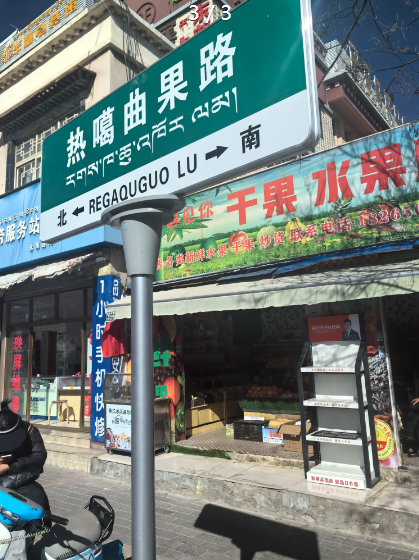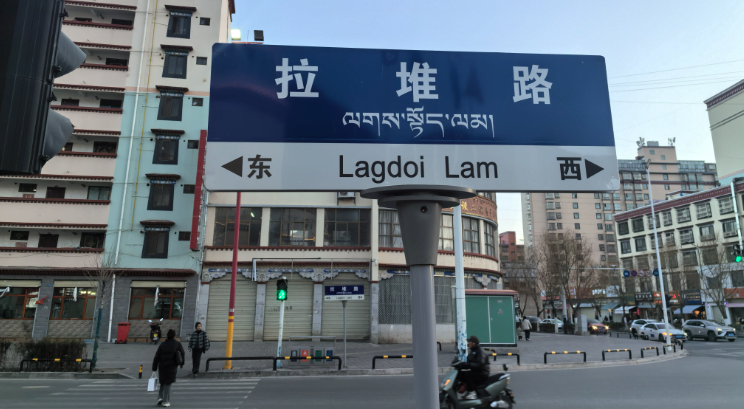Lhasa’s streets are more than just pathways; they are a mosaic of history, culture, and nature. The recent update and repair of road signs in Lhasa have sparked curiosity and discussions among residents. Why are some signs blue and others green? What does “Duodi Road” (དོག་སྡེ་ལམ།) refer to? And why is the Racecourse built at Cisongtang (ཚེས་གསུམ་ཐང་།)? Many of Lhasa’s street names, often transliterated, hold fascinating secrets waiting to be uncovered.
A Glimpse into the Past Through Names
Take “Jiacuo, (རྒྱ་མཚོ་ལམ།)” for instance, which means “sea” in Tibetan and is located north of Lhasa’s Norbulingka. This area, at the end of the Lhasa River, is dotted with lakes, hence its name. As Lhasa sits in a valley, many of its place names reflect the distinct “mountainous and watery colors” of the region.

With urban development, the original natural landscape of Lhasa has been somewhat veiled by modern architecture. Yet, street names like “Barku, (བྲག་རིི་ཁུག།)” meaning rocky ravine, and “Najin, (རྔ་ཆེན་ལམ།)” resembling an elephant’s trunk, offer whispers of the land’s original state. Nowadays, Najin, once resembling an elephant, bustles with activity, and the starry lakes of Jiacuo have been replaced by paved roads. Thankfully, names like “Najin Road” and “Jiacuo Road” keep the memory of Lhasa’s natural beauty alive.
Road Names: A Reflection of Natural and Cultural Changes
Street names in Lhasa are not just geographical markers but carry layers of historical and cultural significance. Cisongtang, named for the horse racing events held on the third day of the first Tibetan month, and “Dosenge Road (རྡོ་སེང་གེ་ལམ།)” named after a historical event, are examples. The debate between transliteration and translation among residents highlights the deep cultural considerations in naming streets in this multi-ethnic, historically rich city.

A Balance Between Meaning and Memory
Some residents argue that transliteration fails to convey the rich meanings behind the names. Others believe that some names, if translated literally, could become cumbersome and lose their familiarity, especially for older generations accustomed to the original names. Yet, some argue that a well-chosen transliteration can showcase Lhasa’s multicultural identity, adding a layer of charm and romance to the city’s landscape.
Lhasa’s street names are a testament to the city’s rich natural features and its historical and cultural evolution. They are a treasure trove of stories, embodying the essence of Lhasa’s heritage and offering a window into the city’s soul. As Lhasa continues to grow and change, these names stand as enduring reminders of its past, inviting residents and visitors alike to explore the depths of its history.
Rigorous Naming Standards: Continuous Improvement of Lhasa’s Street Signs
Lhasa’s place and street names often evoke diverse and personalized interpretations among citizens and tourists. But what are the bases for naming roads in Lhasa? According to the Lhasa Civil Affairs Bureau, the naming of places and streets strictly adheres to the “Regulations on the Administration of Place Names” issued by the State Council.
The Color-Coding of Street Signs
“Based on the national standards for place name signs set by the state’s quality and technical supervision department, east-west streets have signs with blue backgrounds and white letters, while north-south streets have signs with green backgrounds and white letters,”. The recent cleanup, maintenance, and update of street signs are part of a comprehensive urban and rural environmental campaign in Lhasa. Since the campaign’s inception, the bureau has identified 873 damaged, duplicate, unclear, missing, or incorrectly labeled street signs, all of which have now been restored. The bureau plans to continue these improvements.
Principles Behind Naming
According to the “Regulations on the Administration of Place Names” by the State Council, the naming should reflect local geographical, historical, and cultural features, respect the wishes of local residents, incorporate suggestions from experts and scholars, and facilitate everyday life while promoting excellent traditional culture and socialist core values.
“Lhasa is a city where multiple ethnic groups coexist, each with its own language and pronunciation habits. Therefore, when naming a new road or bridge, we aim to preserve historical names and continue the historical context, while also adopting transliteration for standardization and ease of use. Doing good work in place naming will support the economic and social development of Lhasa, facilitate communication among the public, and play a significant role in inheriting historical culture,”
Through meticulous adherence to naming regulations and continuous efforts to maintain and improve street signs, Lhasa ensures that its rich tapestry of cultural and historical heritage is preserved and communicated to all who walk its streets.
Some of Unique Local street name in Lhasa
- 学子大道 སློབ་མའི་ལམ་ཆེན།
- 玉噶路 གཡུལ་ཁ་ལམ།
- 新村路 གྲོང་གསར་ལམ།
- 加荣路 ལྕགས་རོང་ལམ།
- 纳如路 གླང་རུ་ལམ།
- 贡布堂路 སྐུ་འབུམ་ཐང་ལམ།
- 古热路 གུར་ར་ལམ།
- 维巴路 དངུལ་པར་ལམ།
- 桑东巷 ཟམ་གདོང་ལམ།
- 纳嘎路 ན་བཀག་ལམ།
- 卓康巷སྤྲོ་ཁང་སྲང་ལམ།
- 白林公园དཔལ་གླིང་སྤྱི་གླིང་

